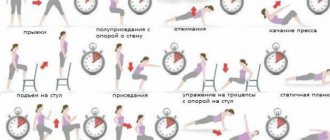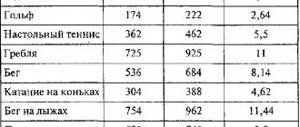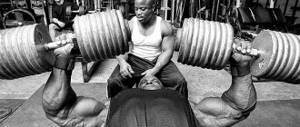What influences the amount of rest
So, there is a lot of different information about what affects how much to rest between sets. I won’t carry snot all over the page and will now try to systematize all the MAIN, in my opinion, factors, as well as analyze in more detail the importance of each of them.
Load direction
To understand how much rest between approaches you need to take into account, first of all, what the load is aimed at. Those. understand why we perform these same approaches. What is our goal?
- Development of maximum strength.
- Gaining muscle mass.
- Losing weight.
- Cutting (fat loss with minimal muscle loss).
So, currently, most strength programs (developing maximum strength) recommend resting from 2.5 to 5 minutes, and for gaining muscle mass from 30 seconds to 1.5 minutes.
This looks quite logical, because... muscle growth, and therefore an increase in strength, is stimulated by lifting heavy weights! And this can be achieved with fully restored reserves of adenosine triphosphate (ATP) and creatine phosphate, which in turn are restored only with a rest of at least 2 minutes.
Workouts aimed at losing weight should contain more cardio load (aerobic), as well as with a large number of repetitions per approach, so the rest between approaches should be reduced from 30 to 60 seconds.
Number of repetitions per set
As a rule, this point is directly related to the direction of the load, but I will still consider it separately. The heavier weights you use, and therefore the fewer repetitions, the more rest time you need between sets.
There are some recommendations in this regard, but they are more than approximate, although it makes sense to pay attention to them:
- in the range of 1-3 repetitions (strength development): rest 2.5-5 minutes;
- in the range of 4-7 repetitions (muscle growth): rest 2-3 minutes;
- in the range of 8-12 repetitions (muscle growth + pumping): rest 1-2 minutes;
- in the range of 13 or more repetitions (endurance development, energy training): rest no more than 1 minute;
Muscle group size
I think the conclusion is one of the simplest! The larger the muscle group, the more time it takes to recover. It's simple.
I will now look at recovery time specifically from the point of view of muscle growth, and not from an increase in strength or endurance. Here are my recommendations in this regard:
- Legs (hips), back, chest: 1.5-2 minutes (for legs it is acceptable to increase the rest to 2.5 minutes).
- Shoulders, arms, legs (lower legs): 45 seconds-1.5 minutes.
Type of muscle fibers trained
I’ll say right away that now I will not consider this issue in detail, because... here is my cool article about muscle fiber types.
I'll say this. Our muscles contain different types of muscle fibers, which are responsible for different intensities of movement, and therefore are trained differently, and also have different recovery times. That's all for now. Just be aware. We will take this factor into account in our conclusions at the end.
Lactic acid
Lactic acid is a metabolic product during anaerobic glycolysis. It is this that causes a burning sensation in working muscles.
Each subsequent approach in terms of the degree of muscle destruction is less effective than the previous ones, due to the gradual decrease in contraction power, because acidic metabolic products (lactic acid) accumulate in the muscle.
Those. It is logical to conclude that all subsequent loads do not enhance the effect of the previous one, because the muscle does not develop maximum strength sufficient to cause microtrauma. And accordingly, REST BETWEEN APPROACHES IS NOT LIMITED BY ANY SPECIAL CONDITIONS other than the time you have allotted for training.
The main thing is that rest ensures that the concentration of lactic acid in the muscle decreases sufficiently so that the muscle can again reach its maximum rate of energy expenditure.
Naturally, complete removal of lactic acid during rest between approaches is impossible, because it takes several hours after training to completely remove it, but a significant part of it is removed in the first few minutes after the approach.
As a rule, 1-2 minutes between sets is enough for sufficient recovery. This time will not completely remove lactic acid from muscle tissue, but it will reduce it enough to allow you to do another full set.
Rest between strength sets
Strength training is typically training in powerlifting and weightlifting.
Strength training involves no more than 4 repetitions per set.
Strength training is more than 80% intensity.
To ensure an intensity of more than 80%, rest between sets should be more than two minutes.
If the intensity of the approaches is more than 90%, then the rest between approaches can increase to 10 minutes.
A strength workout of 30 sets can take up to three hours.
Follow the news on VKontakte/Facebook/Instagram
How much rest between sets and exercises [edit | edit code]
This article is based on the recommendations of Christian Thibadeau, a long-time weightlifter and specialist in developing training programs.
The length of rest breaks between sets directly depends on the program Goal you have chosen. The rules are:
1.
The nervous system needs more time to recover than muscles and metabolic processes.
2.
Incomplete metabolic restoration of processes increases the release of growth hormone, which has a significant effect on changing tissue composition (builds muscle, burns fat). Incomplete recovery may also recruit more motor units (muscle fibers), although these are more likely to be slow twitch ones. But if your goal is maximum mass, then this may be useful to you.
3.
Complete restoration of the central nervous system is necessary for the best development of strength indicators. So in strength training, rest pauses between sets should be long enough to maximize the quality of repetitions.
The choice of rest period is influenced by the intensity of the workout and the type of exercise (you will recover faster from a set of triceps extensions than from squats). The following table shows the effects of different rest periods:
| Time relax | 20-30 seconds | 30-60 seconds | 60-90 seconds | 90-120 seconds | 2-4 minutes |
| Central nervous system restoration | Minor | Small (30-40%) | 40-60% | 60-75% | 80-100% |
| Metabolic restoration | 30-50% | 50-75% | 75-90% | 100% | 100% |
| Key points | Accumulation of metabolites and oxygen debt, leading to release of GH and other growth factors | Still significant metabolite accumulation, but greater metabolic recovery allows for heavier weights for hypertrophy training | A good compromise between metabolite accumulation and sufficient rest for heavy lifting | Allows you to work with full gear in hypertrophy training | Complete restoration of the central nervous system and contractile structures allows you to lift maximum weights |
| Best use | Fat Burning (Strength Endurance Range) | Burn fat and gain muscle mass (strength endurance and hypertrophy range) | Gaining Muscle Mass (Hypertrophy Range) | Gaining muscle mass and developing strength (range of hypertrophy and functional hypertrophy) | Strength development (range of absolute and maximum strength development) |
Thus, depending on your chosen Goal and training intensity, the optimal rest periods between sets will be as follows:
Relative Strength Range (1-3 reps): 3-4 minutes* Absolute Strength Range (3-5 reps): 2-3 minutes* Functional Hypertrophy Range (6-8 reps): 90-120 seconds* Hypertrophy Range I (9 -10 reps): 60-90 seconds* Hypertrophy Range II (11-12 reps): 45-60 seconds* Strength Endurance Range (13-20 reps): 30-45 seconds* Endurance Range (20+ reps): 30 seconds and less “*” – between sets of one exercise
These are general recommendations, as people are different and the rest time can decrease or increase. But most people are better off starting with these ranges and adjusting as needed.
Please note the footnote. This means, for example, that when working on hypertrophy, after 60-90 seconds you do a second approach of the same exercise. For a sequential approach to performing the approaches, everything is simple:
- Bench press 4 x 10 reps, 90 seconds rest
Four sets of ten reps with 90 seconds rest between sets. It couldn't be simpler.
If you use an alternating pattern, it becomes a little more difficult, but not too much. We will alternate bench presses with T-bar rows:
A1. Bench press 4 x 10 A2. T-bar row 4 x 10
We still need to rest 90 seconds between sets of the same exercise, so we'll insert 45 seconds between the press and deadlift:
A1. Bench press 4 x 10, 45 seconds rest A2. T-bar row 4 x 10, 45 seconds rest
Now we have a break of 90 seconds between presses and 90 seconds between rows, however, the training density has increased, which gives additional metabolic effects (fat burning, body recomposition).
How long should you rest between sets? You should know it.
Hello everyone! Today we are waiting for another article on the requests of workers, i.e. You, my dear readers. It has already become our tradition that I answer the most frequently asked questions (via the project feedback form) through articles. The next question on the agenda is how long to rest between sets. During the article, we will get acquainted with the latest scientific data and find out specific figures for respite in the hall.
Let's not put things off, let's go.
The whole truth about how much rest you need between sets
Honestly, I love this kind of article, because the question is formulated precisely - how much rest you need between approaches, it is relevant, quite ambiguous and, among other things, it makes you think. Therefore, the article turns out to be appropriate. Well, I would like to start with the fact that I myself remember the moment when I first came to the hall (I was an absolute idiot) and my very first questions. Most of all I was interested in the following questions: how to quickly pump up the abs, where is the canteen, how many repetitions to do in the exercises, how often to go to the gym, and our current one - how much to rest. In general, a standard gentlemanly set of questions for a newbie.
Of course, I started asking them to more experienced guys and began to receive very varied digital answers: someone spoke for 1 minute, someone for 2-3 , there were cases of 5 , but someone didn’t say anything and just looked at him in silent reproach. - they say, hello, we’ve arrived, another green dumbass has arrived :). I must say that I myself did not sit idly by, but tried in every possible way to dig up the necessary information (including on the Internet). Dig up - I dug up, and this was the standard figure - 45-60 seconds, I calmed down and switched to other, more pressing issues. Over time, I realized that I did not do the right thing, and today you will find out why.
As I said above, the information about how much rest you need is very mixed, and it was based on rumors, guesses and unclear advice, unverified information. I could also say that everyone needs to rest for 1-2 minutes to sow corn and end the article there, but that would be the height of indecency towards you. Therefore, we will not rely on various heresies, but will simply connect the latest scientific research to this question and find out what numerical answer these bright minds offer us.
How long should you rest between sets: research
And we will begin by studying the data of one researcher Jacob Wilson (American doctor of medicine, author of scientific works on one respected bodybuilding resource on the Internet). So, he studied the dependence of muscle growth, strength and power on periods of human rest during training. Let's look at them in a little more detail.
No. 1 Duration of rest. Hypertrophy
The goal of muscle hypertrophy is to create (stimulate) an anabolic environment for the muscles as much as possible. Scientific evidence suggests that this process occurs with shorter rest periods ( 30-60 seconds) as opposed to longer rest periods ( 3-5 minutes). In the study, people performed either 5 or 10 reps per set, with 1 to 3 minutes of rest between sets. Most subjects showed a significant increase in somatotropin with 10 repetitions and 1 minute of rest. This indicates that this time is the optimal rest period for muscle growth.
With a shorter rest period, the human body has much less time to clear itself of lactic acid lactate (the main muscle acidifier when lifting weights).
No. 2. Duration of rest. Strength and Power
When a person trains with weights, they (mostly) use two systems. The first of them is creatine phosphate, the action of which lasts from up to 10 seconds of the entire work and the second is the glycolytic system, which is designed for a period of 30-90 seconds, and in which we use muscle glycogen (or the stored form of carbohydrates) as a source of work.










